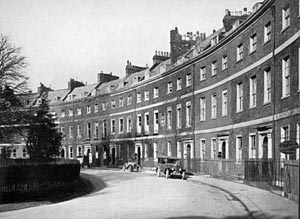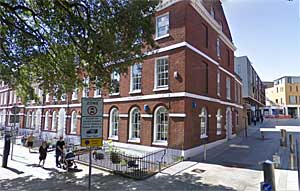
The Devon and Exeter Dental Hospital
Page uploaded on 11th April 2011
The first book devoted to dentistry was the Artzney Buchlein of 1530, while the first book in English was Operator for the Teeth by Charles Allen in 1685; quite sophisticated techniques were adopted including fillings, prosthetic teeth and of course, extractions. False teeth were made of wood, bone and teeth, and long with the introduction of gold fillings and teeth, the wealthy had recourse to some basic care. In the early 19th Century, the poor would often resort to a home remedy or visit an unregulated barber or blacksmith. Mr Sedmond, a surgeon-dentist advertised in the Flying Post in 1802, "He will fix real and artificial Teeth, from one to an entire Set, with superlative Gold Springs and Pivots, in a Mode for superior to any yet practised." During this time, dental-surgeons based in London would place advertisements in the Flying Post, announcing their availability in Exeter to provide dental care to the nobility. In 1836, Mr Lavander of 20 Southernhay was offering a dental service between 10 and 5 o'clock daily; he also offered "Advice to the Poor, Gratis from 9 to 10 o'clock."
In 1847, it was reported that ether was used in Exeter when a large tumour was removed by Mr Land of St Sidwells; the ether was administered by Mr King, a dentist. The report went on to state that Mr Lovander, Mr Hele and various other dentists around the city were regularly using ether.
It was in 1858 that the Odontological Society of The Royal College of Surgeons established the Dental Hospital of London. The Diploma Licentiate in Dental Surgery was introduced in the same year. Unregulated and unqualified dental practitioners still practised, and it was not until 1921 that the Dentist Act outlawed such practitioners by requiring dental surgeons to be registered.
The Dental Hospital
The Dental Hospital of Exeter was first mooted on 15th March 1880 when Mayor Ellis held a meeting for subscribers at the Guildhall. A committee was formed and the first consulting surgeons appointed, before any premises had been found. The committee was charged with collecting donations from subscribers to fund the new institution; Mr Brand agreed to be a life governor, and he had sent a subscription of £10 10s to purchase a set of dental forceps.
The premises, at 15a Bedford Street were leased from the city council for £40 per year, and on the 16th June 1880, the Flying Post reported that the new Dental Hospital had opened for business the previous Monday. Five students were in attendance on the first day to assist the surgeons. On the 11th November, the Royal College of Surgeons agreed to recognise the hospital as a place where students could work towards their diploma. Subscribers to the hospital, who had to pay a guinea, were given five cards which they could pass on to poor citizens to receive free dental care. For a donation of ten guineas, a subscriber would become a life member, and have an unlimited number of cards that they could issue. The demand for treatment was substantial in the early years. The "... relief of persons in poor circumstances and not for those who are enabled to pay for professional assistance" was substantial with 3,624 patients treated in 1881. Of that number, 1,050 were extractions for children, and 2,276 for adults.
The lease on the Bedford Circus premises ended in 1886, as the council required the premises; the committee agreed to start a building fund for new premises. In 1887, an old town house in Castle Street was acquired at a rent of £49 per year. The site became the new library built in 1931, and is now the city registry office and Westcountry Studies Library. Funding the hospital was causing problems by 1890 and the committee decided to widen the catchment area to include Devon; the hospital was renamed the Devon and Exeter Dental Hospital to reflect this. By 1895, 5,000 dental operations were performed, but cash flow was still causing problems for the committee and the hospital was running a deficit.
In 1905, a gift of £2,000 from Mrs Nosworthy of Dawlish enabled the committee to purchase 24 Southernhay West for the sum of £2,000; the premises were on the end of the terrace with an entrance from Bedford Street and are now occupied by Strutt and Parker. The new hospital was formally opened on Friday 28th September 1906 by Mrs Nosworthy, who was presented with a silver key by the architect, which she used to unlock the front door. A sum of £492 8s 7d was used to equip and furnish the new hospital, including covering all the floors with linoleum.
It was only the income from private gifts and legacies that prevented the hospital from running at a loss; in 1908, after Mrs Nosworthy donated a further £500, the income from subscriptions and collections from local churches came to £176 12s 3d while the running costs were £174 0s 5d. A room was converted to a bedroom to allow patients travelling in from the further corners of Devon to stay overnight for treatment. From 1912, the hospital started to provide dentures, for which a small charge would be made. Again, Mrs Nosworthy donated another £500 to provide dentures for deserving patients. The needs of the troops billeted in the city during the First War were recognised, and in 1914, 20 recruits were provided with free dentures. Four of the hospital's surgeons joined up during the war, imposing a strain on the local dental service, and necessitating the hospital to close temporarily on Mondays, Fridays and Saturdays. By the end of the war the number of patients was dropping, partly caused by the introduction of dental treatment in their elementary classes.
The decision was made in 1932 to amalgamate the dental hospital with the Royal Devon And Exeter Hospital and a joint committee formed to manage the affairs of the dental hospital. In 1936, a dental extension was built at the Royal Devon and Exeter Hospital and 24 Southernhay West was closed. The facility consisted of two dental consulting rooms, and operating theatre, recovery room and the use of the library as a waiting room. In 1974, along with the rest of the hospital, the dental department moved to the new building at Wonford. The Maxillofacial Unit still operates at Wonford, while a drop in dental service for those not registered with an NHS dentist is based at Heavitree Hospital.
Sources: Wikipedia, Trewman's Exeter Flying Post, and A History of the Devon and Exeter Dental Hospital by W G Selley (Transactions of the Devonshire Association volume 142)
 The first home, between 1880 and 1886, of the Dental Hospital of Exeter was at 15a Bedford Street.
The first home, between 1880 and 1886, of the Dental Hospital of Exeter was at 15a Bedford Street.  The second home, between 1896 and 1905, of the Devon and Exeter Dental Hospital was in Castle Street, now the site of the Exeter Registry Office.
The second home, between 1896 and 1905, of the Devon and Exeter Dental Hospital was in Castle Street, now the site of the Exeter Registry Office. The third home, between 1905 and 1936, of theDevon and Exeter Dental Hospital was 24 Southernhay West.
The third home, between 1905 and 1936, of theDevon and Exeter Dental Hospital was 24 Southernhay West.
│ Top of Page │